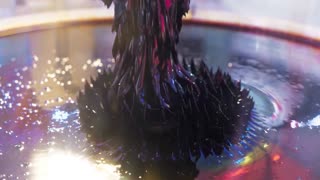The Color of a Star is Determined by Its Surface Temperature
The color of a star is a function of its surface temperature
As a star's temperature increases, as a result of there being more gas in the star – and hence more fuel to burn – it becomes hotter. Its color changes from orange, through yellow, to white. Hottest stars are blue, with temperatures up to 40,000ºC. Coolest stars are red with surface temperatures of about 3,000ºC.
Look at the beautiful picture of the stars in the Sagittarius Star Cloud. The stars show a multitude of colors, including red, orange, yellow, white, and blue. As we have seen, stars are not all the same color because they do not all have identical temperatures. To define color precisely, astronomers have devised quantitative methods for characterizing the color of a star and then using those colors to determine stellar temperatures. In the chapters that follow, we will provide the temperature of the stars we are describing, and this section tells you how those temperatures are determined from the colors of light the stars give off.
https://courses.lumenlearning.com/suny-astronomy/chapter/colors-of-stars/
A normal star is a luminous spheroid of plasma held together by self-gravity.[1] The nearest star to Earth is the Sun. Many other stars are visible to the naked eye at night; their immense distances from Earth make them appear as fixed points of light. The most prominent stars have been categorised into constellations and asterisms, and many of the brightest stars have proper names. Astronomers have assembled star catalogues that identify the known stars and provide standardized stellar designations. The observable universe contains an estimated 1022 to 1024 stars. Only about 4,000 of these stars are visible to the naked eye—all within the Milky Way galaxy
There are seven spectral classes of stars, based on the effective temperatures of their surfaces. In order of descending temperature, they are: O, B, A, F, G, K, and M. O stars are the very hottest, brightest stars, and M stars are the very coolest, dimmest stars
-
 45:30
45:30
AirCondaTV Hobbies
1 month ago $0.09 earnedProject Binary Nova (Ep. 1) - When a White Dwarf Really Loves a Red Giant
172 -
 23:21
23:21
AirCondaTV Hobbies
1 month ago $0.02 earnedProject Binary Nova (Ep. 3) - The Flaming Star Nebula Meets The Blaze Star
38 -
 2:51
2:51
Gotchaplumber
2 months agoWhat do colors of thermostat wires mean?
20 -
 1:51
1:51
WildInformat
25 days agoExploring Natures Rarest Hue | The Color Blue
28 -
 2:24
2:24
SomET
20 days agoSom ET - 81 - Sun - The Active Christmas Eve 2023 Ultraviolet Sun
42 -
 1:04
1:04
Cryptostreets
27 days agoScience Simplified: What Is a Neutron Star?
29 -
 0:42
0:42
rammy612
29 days agoWhite sun/yellow sun
7 -
 1:39
1:39
KGUN
4 years agoCooking with the stars
78 -
 1:00
1:00
AlwanFilm
1 month agoSinners in the Sun Colorized
9 -
 3:47
3:47
Essential Natural Remedies - Physical, Emotional, Mental and Spiritual
1 month agoAll the Colours of the Rainbow
117